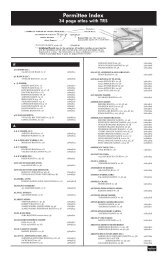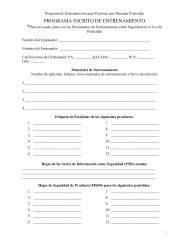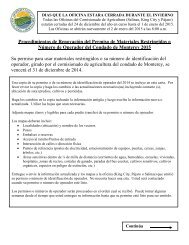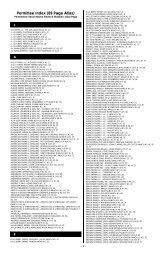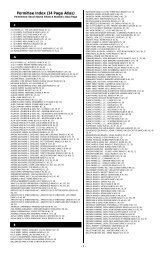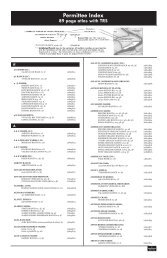Crop Report - Monterey County Agriculture Commissioner's Office
Crop Report - Monterey County Agriculture Commissioner's Office
Crop Report - Monterey County Agriculture Commissioner's Office
You also want an ePaper? Increase the reach of your titles
YUMPU automatically turns print PDFs into web optimized ePapers that Google loves.
Summary Of Sustainable Agricultural Activities<br />
Yellow Starthistle*, Centaurea solstitialis<br />
Italian Thistle, Carduus spp.<br />
Russian Thistle, Salsola australis<br />
Puncture Vine, Tribulus terrestris<br />
Aphid species<br />
Ash Whitefly, Siphoninus phillyreae<br />
COUNTY BIOLOGICAL CONTROL<br />
AGENT / MECHANISM<br />
Seedhead Weevils/Fly,<br />
Bangasternus orientalis, Eustenopus villosus<br />
Urophora sirunaseva, Larinus curtus,<br />
Seedhead weevil, Rhinocyllus conicus<br />
Leaf & stem mining moths, Coleophora spp.<br />
Stem & Seed weevils, and Microlarinus spp.<br />
Seven-spotted lady beetle, Coccinella septempunctata<br />
Parasitic wasp, Encarsia inaron<br />
SCOPE OF PROGRAM<br />
47 Sites<br />
General Distribution<br />
7 sites<br />
General and Local Distribution<br />
1 site<br />
General Distribution<br />
* The hairy seedhead weevil, Eustenopus villosus, is available for release to individual properties with yellow starthistle infestations. Call for arrangements.<br />
PEST ERADICATION<br />
Scotch Thistle, Onopordum acanthium<br />
Skeletonweed, Chrondrilla junceae<br />
Puna Grass, Achnatherum brachychaetum<br />
Mechanical/Chemical<br />
Mechanical/Chemical<br />
Mechanical/Chemica<br />
Hydrilla (Hydrilla verticillata), and biddy-biddy (Acaena novae-zelandiae) have been eradicated.<br />
One Infestation<br />
Two Infestations<br />
Nine Infestations<br />
Roadside (virus host) Weeds<br />
Roadside, Targeted Noxious Weeds<br />
Lettuce Mosaic Virus<br />
Lettuce Mosaic Virus<br />
Celery Mosaic Virus<br />
Lettuce Root Aphid<br />
PEST MANAGEMENT<br />
Chemical<br />
Chemical<br />
Virus-Free Seed<br />
Host-Free Period<br />
Host-Free Period<br />
Quarantine, State Misc. Ruling 3597<br />
<strong>County</strong> right-of-ways, spot treatment<br />
<strong>County</strong> right-of-ways, boom and spot treatment<br />
Indexing of all county-planted seed<br />
No lettuce above ground 12/7-12/21<br />
No celery above ground in January<br />
Lombardy poplar prohibition<br />
PEST DETECTION / EXCLUSION<br />
Pest detection is the systematic search for pests outside of a known infested area, or for pests not known to occur in California. The general goal is to detect pests before<br />
they become established over an area so large that eradication is no longer biologically or economically feasible. Pest exclusion refers to the process of denying entry of<br />
pests into an area by routine inspection of incoming plant shipments and rejection of infested material. Detection trapping is performed primarily by the <strong>County</strong> Agricultural<br />
Commissioner’s offices.<br />
TARGET PESTS INSECT HOSTS NO. OF TRAPPED SERVICINGS<br />
Medfly<br />
Melon Fruit Fly<br />
Mexican Fruit Fly<br />
Oriental Fruit Fly<br />
Misc. Fruit Flies<br />
European Corn Borer<br />
Gypsy Moth<br />
Japanese Beetle<br />
Trogoderma Beetle<br />
Glassy Winged Sharpshooter<br />
Light Brown Apple Moth<br />
Pepper Moth<br />
European Grapevine Moth<br />
Asian Citrus Psyllid<br />
Nantucket Pine Tip Moth<br />
Fruit Trees<br />
Vegetable Gardens<br />
Fruit Trees<br />
Fruit Trees<br />
Fruits and Vegetables<br />
Grains and Vegetables<br />
Shade Trees<br />
Turf, Roses<br />
High Hazard Commodities<br />
Nurseries/Vineyards/Urban Areas<br />
Ornamental/Commercial <strong>Crop</strong>s<br />
Ornamental/Commercial <strong>Crop</strong>s<br />
Grapes<br />
Citrus<br />
Conifers<br />
Pest detection trapping activities accounted for 10,761.5 hours, with a total of 80,679 trap services being made. Two hours were applied to inspecting 5 commercial crop sites of<br />
1.5 net/ 75 gross acres. Two calls to residences were made for investigation of suspect reports and 65.5 hours were utilized on inspection/identification of public-reported pests.<br />
Twenty-seven high hazard locations were inspected and 241 miles of entryways surveyed, accounting for 52.5 and 34.5 hours respectively. Special surveys were made for exotic<br />
invasive weeds, Africanized honeybee, Karnal bunt, mint beetle, citrus greening disease, sudden oak death disease, Asian citrus psyllid, and glassy-winged sharpshooter.<br />
ORGANIC FARMING<br />
One hundred thirteen farms, totaling approximately 19,863 acres of crop land and 9,929 rangeland, were registered in <strong>Monterey</strong> <strong>County</strong> in 2011. Utilizing organic principles<br />
defined in the California Organic Food Act of 2003, these farms produce a wide array of commodities, such as: strawberries, spinach, broccoli, salad mix, celery, lettuces,<br />
cauliflower, raspberries and miscellaneous vegetables. The total estimated value of organic production in <strong>Monterey</strong> <strong>County</strong> during 2011 was $170,352,183. This compares<br />
with 2010 where we had 19,495 production acres and 9,000 acres of rangeland with an estimated value of $168,956,060.<br />
3,430<br />
1,072<br />
2,792<br />
1,484<br />
1,076<br />
34<br />
1,244<br />
1,187<br />
16<br />
15,417<br />
5,474<br />
2<br />
44,355<br />
3,061<br />
35<br />
ag.co.monterey.ca.us | 2011 <strong>Monterey</strong> <strong>County</strong> <strong>Crop</strong> <strong>Report</strong> | 23



